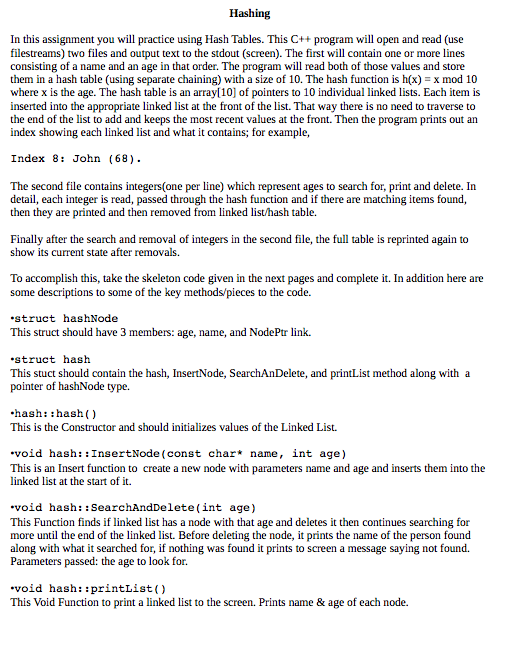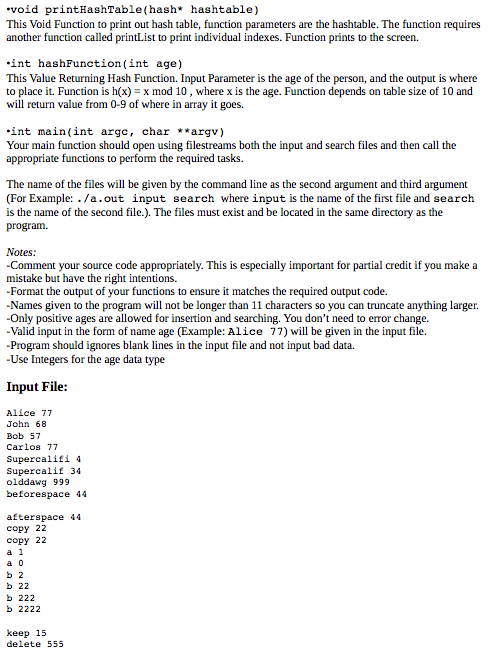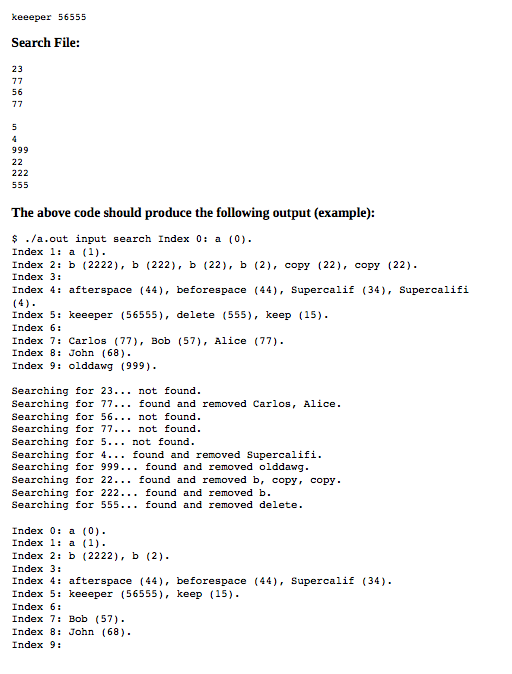Question
Help code in c++ CODE: #include #include #include using namespace std; struct hashNode; typedef hashNode *NodePtr; struct hashNode { /* node to store data in
Help code in c++



CODE:
#include
#include
#include
using namespace std;
struct hashNode;
typedef hashNode *NodePtr;
struct hashNode
{
/* node to store data in linked list */
int age;
char name[13]; //max size 12 + NULL or 11 + + \0
NodePtr link;
};
struct hash
{
hash();
void InsertNode(const char* name, int age);
void SearchAndDelete(int age);
void printList();
hashNode *first;
};
/* Constructor, initializes values of Linked List */
hash::hash()
{
first = NULL;
}
/* Insert function to create a new node with parameters name and age and inserts them into
* linked list at the start of it. */
void hash::InsertNode(const char* name, int age)
{
//Your Code Here
//alloc new node
//copy name to node
//load all values to node
//if empty, set first to a newNodePtr
//else sets it at the front (start) of linked list
}
/* Function finds if linked list has a node with that age and deletes it
then continues
* searching for more until the end of the linked list. Before deleting
the node, it prints
* the name of the person found along with what it searched for, if
nothing was found it
* prints to screen a message saying not found. Parameters passed: the
age to look for */
void hash::SearchAndDelete(int age)
{
string notf = "not found.";
NodePtr current = first;
NodePtr prev = current;
bool itemfound = false;
bool printedfoundmsg = false;
NodePtr dtemp;
cout
//Your Code Here
if (itemfound == false)
cout
else
cout
}
/* Void Function to print a linked list to the screen. Prints name & age
of each node */
void hash::printList()
{
bool firstprint = false; //for printing formatting
NodePtr current = first;
while(current != NULL)
{
if(!firstprint)
{ //for formatting purposes to print the comma/period correctly
cout name age
firstprint = true;
}
else
cout name age
current = current>link;
}
if(firstprint) cout
}
/* Void Function to print out hash table, function parameters are the
hashtable. The
* function requires another function called printList to print
individual indexes.
* Function prints to the screen*/
void printHashTable(hash* hashtable)
{
for (int i = 0; i
{
cout
hashtable[i].printList();
cout
}
}
/* Value Returning Hash Function. Input Parameter is the age of the
person, and the output
* is where to place it. Function is h(x) = x mod 10 , where x is the age. Function
* depends on table size of 10 and will return value from 09 of where
in array it goes */
int hashFunction(int age)
{
//Your Code Here
}
int main(int argc, char **argv)
{ //Start of Main
if(argc !=3)
cout
else
{
//If correct command line argument then program proceeds, otherwise it terminates
char inputname[13];
int inputage;
hash hashtable[10]; //Hash Table size 10
ifstream inf;
inf.open(argv[1]); //open input file with names and ages to store
inf >> inputname >> inputage; //prime read to make sure file isn't empty
while(inf)
{
//Read until end of file
//Call hash function find where to input data in array[x] and then insert it
hashtable[hashFunction(inputage)].InsertNode(inputname, inputage);
inf >> inputname >> inputage; // read next line
} // End of main read while loop
inf.close();
printHashTable(hashtable);
cout
inf.open(argv[2]); //open input file with ages to search for
inf >> inputage; //prime read to make sure file isn't empty
while(inf)
{ //Read until end of file
//Call hash function to find where to search in array and then try deleting
hashtable[hashFunction(inputage)].SearchAndDelete(inputage);
inf >> inputage; //read next line
} // End of main read while loop
inf.close();
cout
printHashTable(hashtable);
}
return (0);
} //End of Main
Hashing In this assignment you will practice using Hash Tables. This C++ program will open and read (use filestreams) two files and output text to the stdout (screen). The first will contain one or more lines consisting of a name and an age in that order. The program will read both of those values and store them in a hash table (using separate chaining) with a size of 10. The hash function is h(x) x mod 10 where x is the age. The hash table is an array 10] of pointers to 10 individual linked lists. Each item is inserted into the appropriate li the end of the list to add and keeps the most recent values at the front. Then the program prints out arn index showing each linked list and what it contains; for example, nked list at the front of the list. That way there is no need to traverse to Index 8John (68) The second file contains integers(one per line) which represent ages to search for, print and delete. In detail, each integer is read, passed through the hash function and if there are matching items found, then they are printed and then removed from linked list/hash table. Finally after the search and removal of integers in the second file, the full table is reprinted again to show its current state after removals. To accomplish this, take the skeleton code given in the next pages and complete it. In addition here are to some of the key methods/pieces to the struct hashNode This struct should have 3 members: age, name, and NodePtr link. struct hash This stuct should contain the hash, InsertNode, SearchAnDelete, and printList method along with a pointer of hashNode type. hash::hash) This is the Constructor and should initializes values of the Linked List. void hash::InsertNode (const char* name, int age) This is an Insert function to create a new node with parameters name and age and inserts them into the linked list at the start of it. void hash::SearchAndDelete(int age) This Function finds if linked list has a node with that age and deletes it then continues searching for more until the end of the linked list. Before deleting the node, it prints the name of the person found along with what it searched for, if nothing was found it prints to screen a message saying not found. Parameters passed: the age to look for. void hash::printList () This Void Function to print a linked list to the screen. Prints name & age of each node
Step by Step Solution
There are 3 Steps involved in it
Step: 1

Get Instant Access to Expert-Tailored Solutions
See step-by-step solutions with expert insights and AI powered tools for academic success
Step: 2

Step: 3

Ace Your Homework with AI
Get the answers you need in no time with our AI-driven, step-by-step assistance
Get Started


